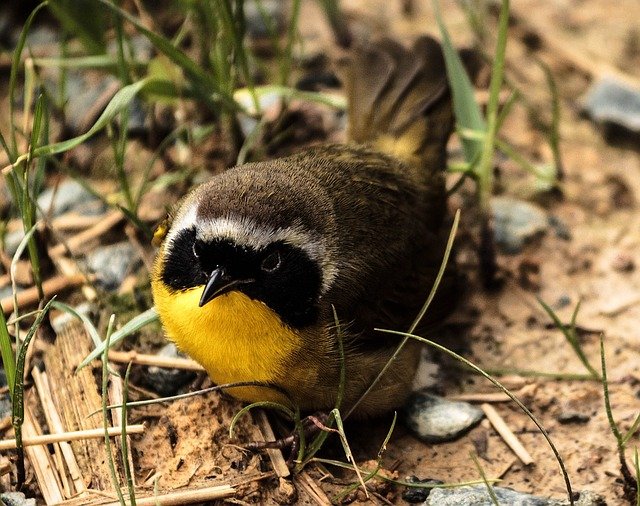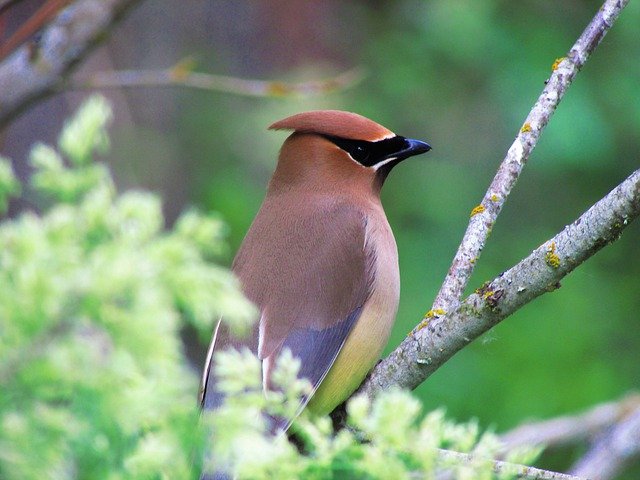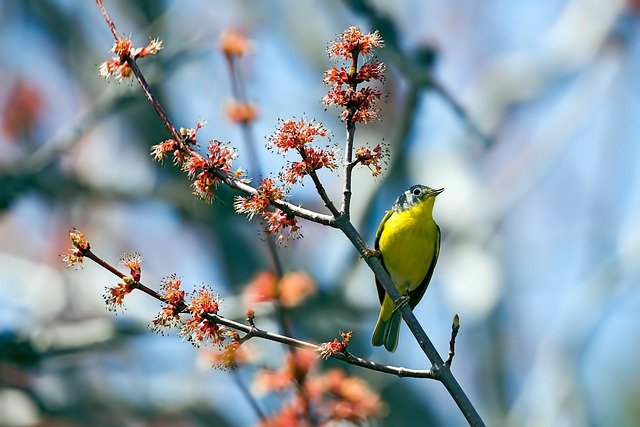If you want to learn about some yellow birds to look out for in Minnesota, this article has you covered. Here I’ll be covering 7 different yellow birds you can look out for the next time you go on a hike with the intention to check out some yellow birds in the wild.
- American Goldfinch
- Baltimore Oriole
- Common Yellowthroat
- Dickcissel
- Cedar Waxwing
- American Yellow Warbler
- Nashville Warbler
7 Yellow Birds In Minnesota
1. American Goldfinch (Spinus Tristis)

- Size: 11 – 13cm
- Weight: 11 – 20 grams
- Wingspan: 19 – 22cm
American goldfinches are year round residents in southern Minnesota and summer residents in northen Minnesota.
These finches are recognised by their yellow, white and black plumage. Their wings are black and white, their forehead is distinguished by the small black patch on it, their under tail is white with the remainder of the body a bright yellow color. Females are far less vibrant with hints of yellow but are mostly light brown in color.
Ameican goldfinches are found around edges of forests and plains, around areas filled with brush and thistle plants within the state of Minnesota.
These finches tend to eat mainly seeds that come from the daisy composite family, seeds from weeds, from trees like birches and elm trees, buds, the occasional insect, maple sap and berries.
American goldfinches are known to live between 2 – 4 years in the wild and upto 9 years in captivity.
2. Baltimore Oriole (Icterus Galbula)

- Size: 15 – 20cm
- Weight: 28 – 43 grams
- Wingspan: 23 – 30cm
Baltimore orioles can be found throughout Minnesota in the summer.
These orioles are recognised by their yellow, black and white plumage, their head and wings that are a black color, their breast and the underside of the tail yellow with a beak that’s black in color. Females are yellow too but, their head isn’t black like the males.
Baltimore orioles can be found within open deciduous woodlands where they will build their nests within American elms, cottonwoods, and maples.
As for the types of food they eat, it includes a variety of small insects like ants, wasps. beetles, grasshoppers, flies among others, flower nectar and smaller fruits like berries. They also feed on sugar water found within feeders.
These orioles are known to live for around 11 years in wild, which is actually on the longer side for birds of their size.
3. Common Yellowthroat (Geothlypis Trichas)

- Size: 11 – 14cm
- Weight: 11 – 15 grams
- Wingspan: 15 – 19cm
Yellowthroats tend to spend their time in Minnesota throughout the summer months.
Common yellowthroats are recognised by their mostly light brown/dirty yellow plumage from their head to tail wihilst their throat is a bright yellow color. Females are mostly yellow with small elements of yellow on their tail and chin whilst males have more elements of black on their face.
As for where you can find these yellowthroats, they can be located around swamps, marshes, wet thickets, edges where they will often breed within wet marshes as well. They also nest within briars, moist brushy places, tangles of rank weeds and shrubbery along streams and overgrown fields.
Common yellowthroats are known to eat smaller insects like ants, spiders, beetles along with seeds and smaller fruits like berries.
These avians can live for around 11 years in the wild.
4. Dickcissel (Spiza Americana)

- Size: 14 – 16cm
- Weight: 23 – 29 grams
- Wingspan: 25 – 26cm
Dickcissels aren’t common in the Minnesota but can be spotted in Minnesota around summer.
Dickcissels are recognised by thier yellow chest, gray belly, brown wings with strips of black, a gray head with a horizontal yellow strip across the eye and silver/gray triangular beak. Females have a similar color scheme but are far duller in their vibrancy and are smaller overall than males too.
Dickcissles are most commonly found around open grassland areas like native prairies, restored grasslands, grazed pastures, hayfields, fallow agricultural fields as well as fencerows and roadsides on occasion.
These birds tend to eat mostly insects and seeds which consists of grasshoppers, caterpillars, termites, flies, wasps, beetles; they also eat spiders as well as seeds of grasses, willows, buckwheat, crops like rice and sorghum.
Dickcissels tend to live for around 4 years on average in the wild.
5. Cedar Waxwing (Bombycilla Cedrorum)

- Size: 15 – 18cm
- Weight: 25 – 35 grams
- Wingspan: 22 – 30cm
Cedar waxwings tend to spend their time in Minnesota year round.
They’re recognised by their plumage that have elements of yellow across their body which can be found on their tail and breast with the remaineder of their body a gradient brownish/gray color with a mask shaped black element on their face and a red strip on their wing. Females look very similar to males with main difference being the darker coloration on the males chin.
Cedar waxwing can be found around open woodlands, fruiting trees, forest edges, streamsides, overgrown fields, edges of swamps, suburban yards and orchards. In the winter months they can sometimes be seen spending their time in towns.
These avains are known to mostly eat fruits and berries with the ones they feed on most often being juniper, dogwood, and wild cherries. They also drink the juices from flowers and eat a variety of small insects like beetles, ants, caterpillars etc.
As for their lifespan, they are often known to live for 8 years in wild.
6. American Yellow Warbler (Setophaga Petechia)

- Size: 12.5 – 13cm
- Weight: 8 – 16 grams
- Wingspan: 16 – 22cm
These warblers can be found spending their time in Minnesota throughout the summer months.
American Yellow Warblers are recognied by their yellow plumage with streaks of brown on its feathers and back. The males have a few more patterns to their plumage but, both the males and females are mostly yellow in color.
As for the habitats in which these little avians tend to spend the majority of their time, it would be bushes, swamp edges, streams and gardens.
Yellow warblers tend to consume insects and berries with 2/3 of their diet mostly consisting of small insects like caterpillars,
beetles, damselflies, treehoppers and more.
These little warblers are known to live upto 10 years although most warblers don’t live nearly as long as that. Often a warblers will live closer to 2 – 5 years in the wild as opposed to the full 10.
7. Nashville Warbler (Leiothlypis Ruficapilla)

- Size: 11 – 13cm
- Weight: 6.7 – 13.9 grams
- Wingspan: 17 – 20cm
These warblers spend their summer months in northeastern Minnesota whilst migrating throughout the spring and fall.
Nashville warblers are recognised by their gray, light brown and yellow plumage where their head is a gray color, the upper half of their body is a light brown color and the lower half is a vibrant yellow color. Males and females look more or less the same.
As for where you will find a nashville warbler in the wild, it’ll often be near shrubby, second-growth habitats such as around mixed-species forests, tamarack, spruce, or scrub oak in elevations between 3,300 and 5,400 feet.
Nashville warblers consume a variety of different food sources. These sources includes insects like caterpillars to flies, seeds like black sunflower seeds, arthropods, berries and even nectar in the winter months.
The longest living Nashville warbler happend to stay alive untill they were 10 years old however, the average lifespan is a likely a good bit shorter.
Related
If you want to find out about red birds in Minnesota Click Here
If you want to find out about orange birds in Minnesota Click Here
If you want to find out about big birds in Minnesota Click Here
If you want to find out about green birds in Minnesota Click Here
If you want to find out about birds of prey birds in Minnesota Click Here
If you to find our about white birds in Minnesota Click Here
Amhil Khan, a dedicated nature enthusiast and the founder of BirdsOfTheWild.com, is a passionate advocate for the captivating world of avian wonders. With a deep-seated curiosity about the intricate lives of birds, Amhil’s journey began as a fascination and has evolved into a mission to inspire others to appreciate and protect these magnificent creatures.
Amhil’s love for birds led to the creation of Birds of the Wild, a platform where his expertise in ornithology, coupled with his captivating storytelling, provides readers with an immersive and educational experience. Through his lens and words, he captures the essence of birds in their natural habitats, offering a glimpse into their behaviors, migrations, and the ecosystems they inhabit.
